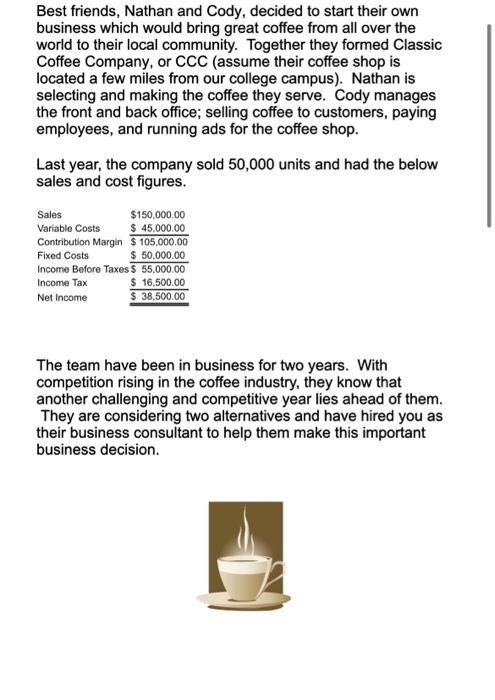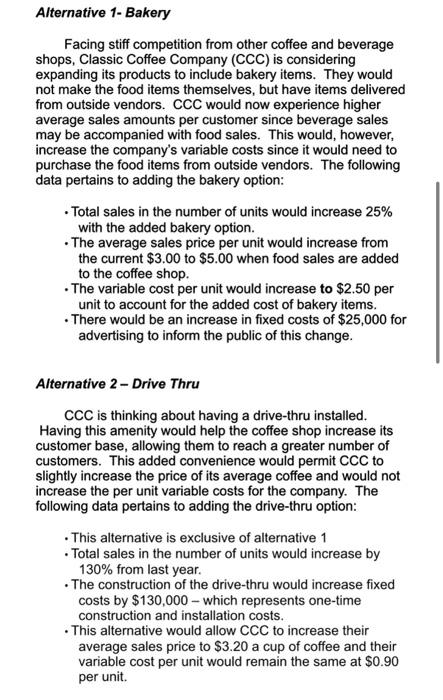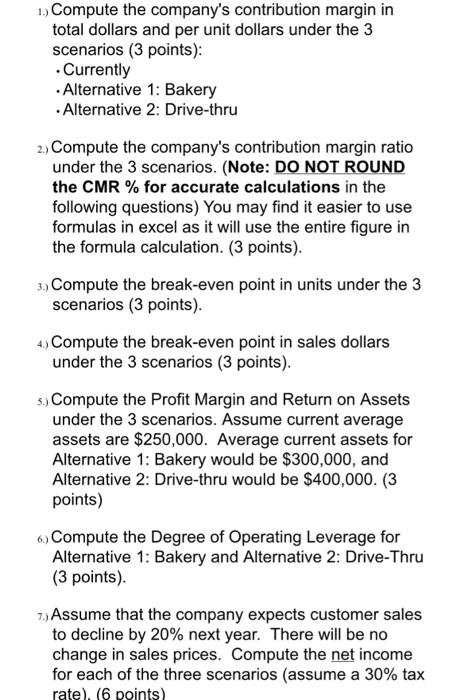1.) Compute the company's contribution margin in total dollars and per unit dollars under the 3 scenarios (3 points): - Currently - Alternative 1: Bakery -Alternative 2: Drive-thru 2.) Compute the company's contribution margin ratio under the 3 scenarios. (Note: DO NOT ROUND the CMR \\% for accurate calculations in the following questions) You may find it easier to use formulas in excel as it will use the entire figure in the formula calculation. ( 3 points). 3.) Compute the break-even point in units under the 3 scenarios (3 points). 4.) Compute the break-even point in sales dollars under the 3 scenarios ( 3 points). 5.) Compute the Profit Margin and Return on Assets under the 3 scenarios. Assume current average assets are \\( \\$ 250,000 \\). Average current assets for Alternative 1: Bakery would be \\( \\$ 300,000 \\), and Alternative 2: Drive-thru would be \\( \\$ 400,000 \\). (3 points) 6.) Compute the Degree of Operating Leverage for Alternative 1: Bakery and Alternative 2: Drive-Thru (3 points). 7.) Assume that the company expects customer sales to decline by \20 next year. There will be no change in sales prices. Compute the net income for each of the three scenarios (assume a 30\\% tax rate) ( 6 points) Facing stiff competition from other coffee and beverage shops, Classic Coffee Company (CCC) is considering expanding its products to include bakery items. They would not make the food items themselves, but have items delivered from outside vendors. CCC would now experience higher average sales amounts per customer since beverage sales may be accompanied with food sales. This would, however, increase the company's variable costs since it would need to purchase the food items from outside vendors. The following data pertains to adding the bakery option: - Total sales in the number of units would increase \25 with the added bakery option. - The average sales price per unit would increase from the current \\( \\$ 3.00 \\) to \\( \\$ 5.00 \\) when food sales are added to the coffee shop. - The variable cost per unit would increase to \\( \\$ 2.50 \\) per unit to account for the added cost of bakery items. - There would be an increase in fixed costs of \\( \\$ 25,000 \\) for advertising to inform the public of this change. Alternative 2 - Drive Thru \\( \\mathrm{CCC} \\) is thinking about having a drive-thru installed. Having this amenity would help the coffee shop increase its customer base, allowing them to reach a greater number of customers. This added convenience would permit CCC to slightly increase the price of its average coffee and would not increase the per unit variable costs for the company. The following data pertains to adding the drive-thru option: - This alternative is exclusive of alternative 1 - Total sales in the number of units would increase by \130 from last year. - The construction of the drive-thru would increase fixed costs by \\( \\$ 130,000 \\) - which represents one-time construction and installation costs. - This alternative would allow CCC to increase their average sales price to \\( \\$ 3.20 \\) a cup of coffee and their variable cost per unit would remain the same at \\( \\$ 0.90 \\) per unit. 6.) Compute the Degree of Operating Leverage for Alternative 1: Bakery and Alternative 2: Drive-Thru (3 points). 7.) Assume that the company expects customer sales to decline by \20 next year. There will be no change in sales prices. Compute the net income for each of the three scenarios (assume a \30 tax rate). (6 points) 8.) Assume that the company expects customer sales to increase by \20 next year. There will be no change in sales prices. Compute the net income for each of the three scenarios (assume a 30\\% tax rate). (6 points) 9.) Compute the sales units required if the company wishes to generate a Target Income Before Taxes of \\( \\$ 100,000 \\) for all 3 scenarios. (6 points) 10.) What would the net income be under Alternative 1-Bakery and Alternative 2-Drive-Thru if CCC was unable to increase sales in units (sales units remain the same as last year)? (4 points). 11.) The company can only pick one of the alternatives (Either Bakery or Drive-Thru), due to the time and resources involved. Analyze and compare your calculations above for alternative 1 and alternative 2, which alternative do you recommend to Nathan and Cody? Explain which alternative you recommend and why. You will need to state 2 qualitative reasons and 3 quantitative (financial) Best friends, Nathan and Cody, decided to start their own business which would bring great coffee from all over the world to their local community. Together they formed Classic Coffee Company, or CCC (assume their coffee shop is located a few miles from our college campus). Nathan is selecting and making the coffee they serve. Cody manages the front and back office; selling coffee to customers, paying employees, and running ads for the coffee shop. Last year, the company sold 50,000 units and had the below sales and cost figures. The team have been in business for two years. With competition rising in the coffee industry, they know that another challenging and competitive year lies ahead of them. They are considering two alternatives and have hired you as their business consultant to help them make this important business decision










